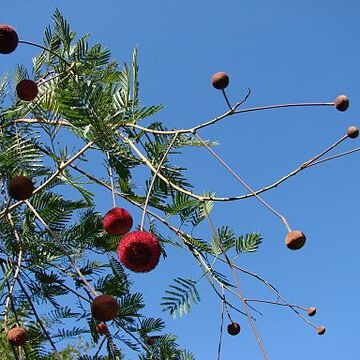Trees, without spines or prickles. Leaves bipinnate; leaflets ± numerous; petiole usually glandular on its upper side. Inflorescences capitate, shortly claviform (with a globose apical part abruptly narrowed into a ± short cylindrical neck) or (but not in the African species) globose or constricted in the middle; heads stalked, solitary or paniculate. Flowers in upper part of heads hermaphrodite, in lower part ♂ or neuter. Calyx infundibuliform or long-tubular, gamosepalous, with 4–5 imbricate segments, 2 larger and 2–3 smaller, the mouth of the calyx being thus irregular. Corolla with 5 petals, which are free, or ± united, not much exceeding the calyx. Stamens 10, all fertile, their filaments connate below into a tube, to which the petals may be also adnate; anthers eglandular. Ovary usually stipitate. Pods oblong to linear, straight or curved, dehiscent or not, usually ± thick and often woody, or somewhat fleshy when living. Seeds ellipsoid to ellipsoid-oblong, ± compressed or flattened.
Trees, unarmed. Leaves bipinnate, with numerous pinnae and leaflets. Inflorescences solitary and axillary, or several at apices of branches, large and clavate or depressed globose, pedunculate. Flowers very numerous. Fertile flowers (bisexual) at upper part of heads, yellow to red, lower sterile ones (male or neuter) white or red. Calyx cylindric; teeth 5, very short and imbricate. Petals 5, linear-spatulate, free or connate to middle. Stamens 10, free or connate at base and adnate to corolla; anthers oblong, usually tipped by a gland. Ovary sessile or stipitate; ovules numerous; style filiform; stigma terminal. Petals of lower sterile flowers often free. Staminodes 10, in a long bundle, free distally, filiform. Legume straight or curved, oblong or elongate, compressed, rather woody or fleshy, 2-valved. Seeds transverse, ovoid, thick or compressed; pleurogram if present ± elliptic.
Inflorescence capitate, shortly claviform (with a globose apical part abruptly narrowed into a ± short cylindric neck) or (but not in the African species) globose or constricted in the middle; heads stalked, solitary or paniculate.
Calyx infundibuliform or long-tubular, gamosepalous, with 4-5 imbricate segments, 2 larger and 2-3 smaller, the mouth of the calyx being thus irregular.
Pods oblong to linear, straight or curved, dehiscent or not, usually ± thick and often woody, or somewhat fleshy when living.
Stamens 10, all fertile, their filaments connate below into a tube, to which the petals may be adnate; anthers eglandular.
Leaves 2-pinnate; leaflets ± numerous; petiole usually glandular on its upper side.
Corolla with 5 petals, which are free or ± united, not much exceeding the calyx.
Flowers in upper part of heads hermaphrodite, in lower part male or neuter.
Seeds ellipsoid to ellipsoid-oblong, ± compressed or flattened.
Trees without spines or prickles.
Root-nodules not yet recorded.
Ovary usually stipitate.


